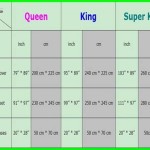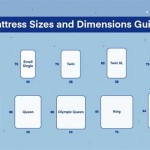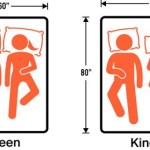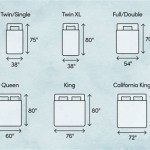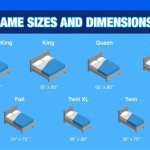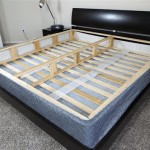What is the Average Size of a Queen Size Bed?
The queen size bed is a popular choice for individuals and couples seeking a balance between space and affordability. Understanding the average dimensions of a queen size bed is crucial when planning a bedroom layout, selecting bedding, and ensuring comfortable sleep for those who will use it. While the term "queen size" implies a standardized measurement, slight variations can occur depending on the manufacturer, style, and intended use. This article provides a detailed exploration of the typical dimensions of a queen size bed, factors that influence these measurements, and considerations for selecting the right size for specific needs.
The average dimensions for a queen size bed are generally accepted as 60 inches (152.4 cm) in width and 80 inches (203.2 cm) in length. These measurements refer to the sleeping surface of the mattress itself. However, when considering the overall dimensions of the bed, including the frame or headboard, these measurements can increase. Therefore, it's essential to not only consider the mattress size but also the total footprint of the bed within the bedroom.
Standard Queen Size Dimensions: Width and Length
The primary factor defining a queen size bed is its dimensions. As previously mentioned, the standard width is 60 inches or five feet. This width provides ample space for two average-sized adults to sleep comfortably without feeling cramped. It offers sufficient personal space compared to a full-size bed, which is narrower. The 80-inch length, equivalent to six feet and eight inches, caters to individuals of average or slightly taller height. This length allows most adults to stretch out fully without their feet extending beyond the mattress edge.
This standardized size makes it relatively easy to find bedding, such as sheets, comforters, and mattress protectors, specifically designed for queen size beds. Retailers and manufacturers widely produce bedding accessories that adhere to these dimensions, ensuring a good fit and consistent appearance.
However, it's important to acknowledge that minor variations can exist. Certain manufacturers might produce queen size mattresses that are slightly wider or longer than the standard measurements, although these differences are typically within a small range, such as an inch or two. These variations are often due to manufacturing tolerances or specific design features aimed at enhancing comfort or aesthetics.
Factors Affecting Queen Size Bed Dimensions
Several factors can influence the actual dimensions of a queen size bed, impacting the overall space it occupies within a room. These factors extend beyond the mattress itself and include the bed frame, headboard, footboard, and any decorative additions. Understanding these influences is crucial for accurate space planning and ensuring the bed fits comfortably within the intended bedroom.
Firstly, the bed frame significantly affects the overall dimensions. Frames come in various styles, including platform frames, sleigh beds, and traditional frames with headboards and footboards. A platform frame, which supports the mattress directly, may add minimal extra length or width compared to the mattress measurements. However, frames with elaborate headboards or footboards can increase the overall length and width by several inches.
Secondly, the headboard is a major factor. Headboards can range from simple, minimalist designs to large, ornate structures. A tall or wide headboard can add substantial length and width to the bed. It is essential to measure the headboard's dimensions and account for them when determining the space required for the bed.
Thirdly, the presence of a footboard also impacts the overall length of the bed. Similar to headboards, footboards vary in design and size. A tall or bulky footboard can increase the total length of the bed, which needs to be considered, especially in smaller bedrooms where space is limited.
Finally, the style of the mattress itself can also contribute to slight variations. Some mattresses, particularly those with pillow tops or Euro tops, may appear slightly larger due to the extra padding and cushioning. While the core dimensions remain consistent, the additional layers can give the impression of a more substantial size.
When purchasing a queen size bed, it's recommendable to review the manufacturer's specifications carefully to confirm the exact dimensions, including the frame, headboard, and footboard if applicable. These specifications typically provide precise measurements that can be used for space planning and ensuring the bed fits comfortably within the bedroom.
Queen Size Bed vs. Other Sizes: A Comparative Analysis
Understanding the dimensions of a queen size bed becomes even more relevant when comparing it to other standard mattress sizes. The most common alternatives are full-size, twin, king, and California king beds. Each size offers different advantages and disadvantages depending on the user's needs and room space available.
A full-size bed, also known as a double bed, is smaller than a queen size bed, typically measuring 54 inches in width and 75 inches in length. While a full-size bed may be sufficient for a single sleeper, it can feel cramped for couples. The queen size bed offers an additional six inches in width and five inches in length, providing significantly more personal space for two adults to sleep comfortably.
A twin bed, typically measuring 38 inches in width and 75 inches in length, is designed primarily for single sleepers, such as children or teenagers. Two twin beds can be pushed together to roughly approximate a king-size bed, but there will be a gap in the middle. A queen bed provides significantly more space for a single adult and is clearly unfit for two unrelated adults.
A king size bed, the largest standard size, typically measures 76 inches in width and 80 inches in length. This provides significantly more space for couples who prefer ample personal space while sleeping. Compared to a queen size bed, a king size bed offers an additional 16 inches in width, making it ideal for couples who move around frequently during sleep or share the bed with pets or children.
A California king bed is another option for those seeking a larger sleeping surface. It typically measures 72 inches in width and 84 inches in length. While narrower than a standard king size bed, it offers an additional four inches in length, making it suitable for taller individuals. A queen size bed is generally better for standard height, due to its more compact size.
The choice between these sizes depends on several factors, including the number of sleepers, the size of the bedroom, and personal preferences for space and comfort. For couples seeking a balance between space and affordability, a queen size bed often provides an ideal solution. However, if space is not a constraint and maximum personal space is desired, a king or California king size bed may be more suitable.
Ultimately, the dimensions of a queen size bed are critical to understanding its usability and suitability for different scenarios. Taking the time to understand the standard measurements and the factors that influence them will facilitate the process of choosing the right bed and bedroom accessories. This knowledge is essential to effectively design and utilize the bedroom space.

Mattress Sizes Chart And Bed Dimensions Guide Amerisleep

Queen Size Bed Dimensions Compared To Other Sizes Eachnight

Queen Bed Dimensions A Ing Guide Nectar Sleep

Queen Size Mattress Dimensions How Big Is A Bed

2024 Bed Frame Sizes Mattress Dimensions Australia B2c Furniture
Bed Mattress Sizes Australia 2024 Guide Sealy

The Average Bedroom Size Design Tips
Queen Size Bed Dimensions In Feet And Centimeters Complete Guide

King Vs Queen Bed Size Mattress What Is The Difference Nectar Sleep

Mattress Sizes And Bed Dimensions 2024


